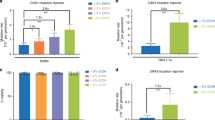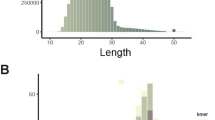Abstract
In nature, organisms are exposed to chronic low-dose ultraviolet light (CLUV) as opposed to the acute high doses common to laboratory experiments. Analysis of the cellular response to acute high-dose exposure has delineated the importance of direct DNA repair by the nucleotide excision repair pathway1 and for checkpoint-induced cell cycle arrest in promoting cell survival2. Here we examine the response of yeast cells to CLUV and identify a key role for the RAD6–RAD18–RAD5 error-free postreplication repair (RAD6 error-free PRR) pathway3,4 in promoting cell growth and survival. We show that loss of the RAD6 error-free PRR pathway results in DNA-damage-checkpoint-induced G2 arrest in CLUV-exposed cells, whereas wild-type and nucleotide-excision-repair-deficient cells are largely unaffected. Cell cycle arrest in the absence of the RAD6 error-free PRR pathway was not caused by a repair defect or by the accumulation of ultraviolet-induced photoproducts. Notably, we observed increased replication protein A (RPA)– and Rad52–yellow fluorescent protein foci5 in the CLUV-exposed rad18Δ cells and demonstrated that Rad52-mediated homologous recombination is required for the viability of the rad18Δ cells after release from CLUV-induced G2 arrest. These and other data presented suggest that, in response to environmental levels of ultraviolet exposure, the RAD6 error-free PRR pathway promotes replication of damaged templates without the generation of extensive single-stranded DNA regions. Thus, the error-free PRR pathway is specifically important during chronic low-dose ultraviolet exposure to prevent counter-productive DNA checkpoint activation and allow cells to proliferate normally.
This is a preview of subscription content, access via your institution
Access options
Subscribe to this journal
Receive 51 print issues and online access
$199.00 per year
only $3.90 per issue
Buy this article
- Purchase on Springer Link
- Instant access to full article PDF
Prices may be subject to local taxes which are calculated during checkout




Similar content being viewed by others
References
Shuck, S. C., Short, E. A. & Turchi, J. J. Eukaryotic nucleotide excision repair: from understanding mechanisms to influencing biology. Cell Res. 18, 64–72 (2008)
Kastan, M. B. & Bartek, J. Cell-cycle checkpoints and cancer. Nature 432, 316–323 (2004)
Ulrich, H. D. The RAD6 pathway: control of DNA damage bypass and mutagenesis by ubiquitin and SUMO. ChemBioChem 6, 1735–1743 (2005)
Andersen, P. L., Xu, F. & Xiao, W. Eukaryotic DNA damage tolerance and translesion synthesis through covalent modifications of PCNA. Cell Res. 18, 162–173 (2008)
Lisby, M., Barlow, J. H., Burgess, R. C. & Rothstein, R. Choreography of the DNA damage response: spatiotemporal relationships among checkpoint and repair proteins. Cell 118, 699–713 (2004)
Friedberg, E. C. How nucleotide excision repair protects against cancer. Nature Rev. Cancer 1, 22–33 (2001)
Prakash, S., Sung, P. & Prakash, L. DNA repair genes and proteins of Saccharomyces cerevisiae . Annu. Rev. Genet. 27, 33–70 (1993)
Harm, W. Biological determination of the germicidal activity of sunlight. Radiat. Res. 40, 63–69 (1969)
Callegari, A. J. & Kelly, T. J. UV irradiation induces a postreplication DNA damage checkpoint. Proc. Natl Acad. Sci. USA 103, 15877–15882 (2006)
Hoeijmakers, J. H. Genome maintenance mechanisms for preventing cancer. Nature 411, 366–374 (2001)
Friedberg, E. C. et al. DNA repair: from molecular mechanism to human disease. DNA Repair (Amst.) 5, 986–996 (2006)
Giavara, S. et al. Yeast Nhp6A/B and mammalian Hmgb1 facilitate the maintenance of genome stability. Curr. Biol. 15, 68–72 (2005)
Prakash, S., Johnson, R. E. & Prakash, L. Eukaryotic translesion synthesis DNA polymerases: specificity of structure and function. Annu. Rev. Biochem. 74, 317–353 (2005)
Hoege, C., Pfander, B., Moldovan, G. L., Pyrowolakis, G. & Jentsch, S. RAD6-dependent DNA repair is linked to modification of PCNA by ubiquitin and SUMO. Nature 419, 135–141 (2002)
Stelter, P. & Ulrich, H. D. Control of spontaneous and damage-induced mutagenesis by SUMO and ubiquitin conjugation. Nature 425, 188–191 (2003)
Zhang, H. & Lawrence, C. W. The error-free component of the RAD6/RAD18 DNA damage tolerance pathway of budding yeast employs sister-strand recombination. Proc. Natl Acad. Sci. USA 102, 15954–15959 (2005)
Blastyak, A. et al. Yeast Rad5 protein required for postreplication repair has a DNA helicase activity specific for replication fork regression. Mol. Cell 28, 167–175 (2007)
Zou, L. & Stillman, B. Formation of a preinitiation complex by S-phase cyclin CDK-dependent loading of Cdc45p onto chromatin. Science 280, 593–596 (1998)
Foiani, M. et al. DNA damage checkpoints and DNA replication controls in Saccharomyces cerevisiae . Mutat. Res. 451, 187–196 (2000)
Zou, L. & Elledge, S. J. Sensing DNA damage through ATRIP recognition of RPA-ssDNA complexes. Science 300, 1542–1548 (2003)
Paciotti, V., Clerici, M., Lucchini, G. & Longhese, M. P. The checkpoint protein Ddc2, functionally related to S. pombe Rad26, interacts with Mec1 and is regulated by Mec1-dependent phosphorylation in budding yeast. Genes Dev. 14, 2046–2059 (2000)
Sun, Z., Hsiao, J., Fay, D. S. & Stern, D. F. Rad53 FHA domain associated with phosphorylated Rad9 in the DNA damage checkpoint. Science 281, 272–274 (1998)
Rupp, W. D. & Howard-Flanders, P. Discontinuities in the DNA synthesized in an excision-defective strain of Escherichia coli following ultraviolet irradiation. J. Mol. Biol. 31, 291–304 (1968)
Prakash, L. Characterization of postreplication repair in Saccharomyces cerevisiae and effects of rad6, rad18, rev3 and rad52 mutations. Mol. Gen. Genet. 184, 471–478 (1981)
Lopes, M., Foiani, M. & Sogo, J. M. Multiple mechanisms control chromosome integrity after replication fork uncoupling and restart at irreparable UV lesions. Mol. Cell 21, 15–27 (2006)
Fanning, E., Klimovich, V. & Nager, A. R. A dynamic model for replication protein A (RPA) function in DNA processing pathways. Nucleic Acids Res. 34, 4126–4137 (2006)
Gangavarapu, V., Prakash, S. & Prakash, L. Requirement of RAD52 group genes for postreplication repair of UV-damaged DNA in Saccharomyces cerevisiae . Mol. Cell. Biol. 27, 7758–7764 (2007)
Heller, R. C. & Marians, K. J. Replisome assembly and the direct restart of stalled replication forks. Nature Rev. Mol. Cell Biol. 7, 932–943 (2006)
Hishida, T., Ohno, T., Iwasaki, H. & Shinagawa, H. Saccharomyces cerevisiae MGS1 is essential in strains deficient in the RAD6-dependent DNA damage tolerance pathway. EMBO J. 21, 2019–2029 (2002)
Longtine, M. S. et al. Additional modules for versatile and economical PCR-based gene deletion and modification in Saccharomyces cerevisiae . Yeast 14, 953–961 (1998)
Hishida, T., Ohya, T., Kubota, Y., Kamada, Y. & Shinagawa, H. Functional and physical interaction of yeast Mgs1 with PCNA: impact on RAD6-dependent DNA damage tolerance. Mol. Cell. Biol. 26, 5509–5517 (2006)
Pellicioli, A. et al. Activation of Rad53 kinase in response to DNA damage and its effect in modulating phosphorylation of the lagging strand DNA polymerase. EMBO J. 18, 6561–6572 (1999)
Schepers, A. & Diffley, J. F. Mutational analysis of conserved sequence motifs in the budding yeast Cdc6 protein. J. Mol. Biol. 308, 597–608 (2001)
Kamimura, Y., Tak, Y. S., Sugino, A. & Araki, H. Sld3, which interacts with Cdc45 (Sld4), functions for chromosomal DNA replication in Saccharomyces cerevisiae . EMBO J. 20, 2097–2107 (2001)
Acknowledgements
We thank R. Rothstein and H. Araki for strains; T. Matsunaga for anti-thymine dimer monoclonal antibody (designated TDM2 antibody); and T. Ohya for technical assistance. This work was supported by the Sumitomo foundation, by Grants-in-Aid for Scientific Research from the Ministry of Education, Culture, Sports, Science and Technology of Japan, and by the MRC (UK) grant G0600233.
Author Contributions T.H. designed the study. T.H. and Y.K. performed the experiments. H.I. coordinated the study. T.H., H.I. and A.M.C. analysed data and wrote the paper.
Author information
Authors and Affiliations
Corresponding author
Supplementary information
Supplementary Information
This file contains Supplementary Tables 1-3, Supplementary References and Supplementary Figures 1-10 with Legends. (PDF 2487 kb)
Rights and permissions
About this article
Cite this article
Hishida, T., Kubota, Y., Carr, A. et al. RAD6–RAD18–RAD5-pathway-dependent tolerance to chronic low-dose ultraviolet light. Nature 457, 612–615 (2009). https://doi.org/10.1038/nature07580
Received:
Accepted:
Published:
Issue Date:
DOI: https://doi.org/10.1038/nature07580
This article is cited by
-
Visualization of recombination-mediated damage bypass by template switching
Nature Structural & Molecular Biology (2014)
-
Causes and consequences of replication stress
Nature Cell Biology (2014)
-
In vivo and in silico analysis of PCNA ubiquitylation in the activation of the Post Replication Repair pathway in S. cerevisiae
BMC Systems Biology (2013)
-
A UVR-Induced G2-Phase Checkpoint Response to ssDNA Gaps Produced by Replication Fork Bypass of Unrepaired Lesions Is Defective in Melanoma
Journal of Investigative Dermatology (2012)
-
Ubiquitin signalling in DNA replication and repair
Nature Reviews Molecular Cell Biology (2010)
Comments
By submitting a comment you agree to abide by our Terms and Community Guidelines. If you find something abusive or that does not comply with our terms or guidelines please flag it as inappropriate.



